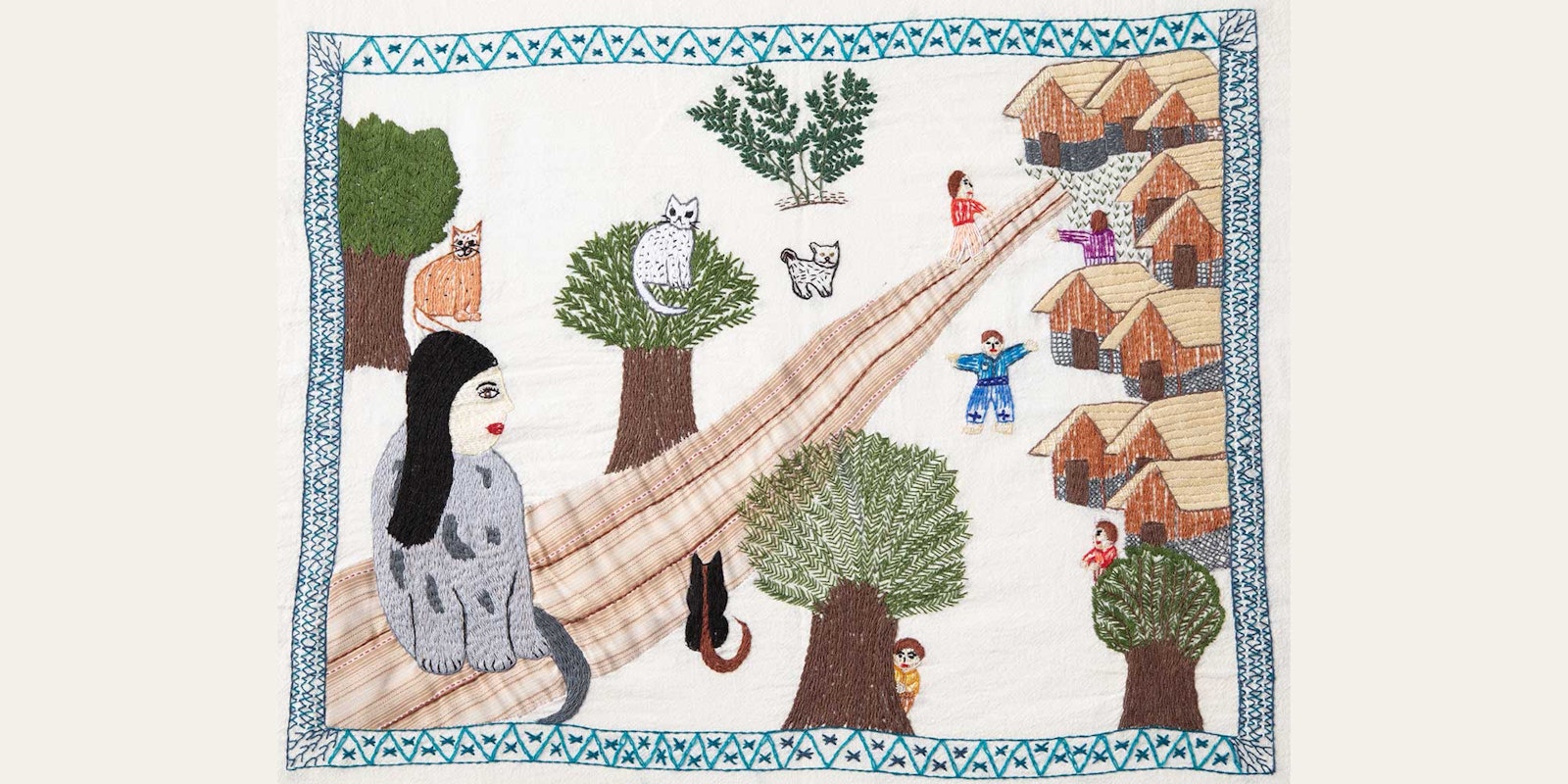The Multicolores embroidery project began in 2016 as a way to expand income-earning opportunities for rural women. We had initiated a rug-hooking project in 2009, and within a few years, the project was established and had garnered international recognition. Still, we were cautious about growing our production faster than our sales and felt reluctant to train more women to make rugs. But then, over time, neighbors of the rug makers observed how the lives of their friends in the rug project were changing.

Detail of The History of the Characoteles, by Concepcion Coo Quieju (left), and Untitled, by Margarita Xicon Burrion (right).
In Guatemala, for those with little education, opportunities to earn income are rare. Opportunities to earn fair wages working from home are even rarer. And so, when neighbors of the rug hookers noticed their friends’ lives improving, adding a potable waterpipe or buying a wooden wardrobe to store clothing so rats couldn’t chew it, they wondered how they, too, might access that opportunity.

The Proposal by Ana Elvira Cubur Solloy. 9×9 inches (22.9×22.9 cm). This piece describes the custom of marriage proposals. A young man enlists the help of his female relatives to bring food and liquor to the home of the young woman he wants to marry. One person runs ahead to speak to the young woman’s father, and later, they all eat and drink together. Everyone enjoys the spectacle, even the neighbors who observe from their homes.
At the same time, the Multicolores team wondered about proving the rug-hooking design curriculum as a model where participants learn technical and design skills to create one-of-a-kind works. We concluded that embroidery, like rug hooking, would be compatible with the way the women’s lives are organized because it’s portable. Embroidery can be picked up and set down as a woman moves throughout her day filled with domestic chores.

The Story of Don Patricio by Ramona Lucia Garcia. 9×9 inches (22.9×22.9 cm). Don Patricio, a Maya priest and spiritual guide, rises with the sun each day and gives thanks to the 20 Mayanahuales, humans who can shape-shift. He prays forthe earth’s cycles, understanding that each day has a correspondingnahualsymbol. According to the characteristics of that symbol and its place in the balance of Maya cosmology, each day will be different.
Having decided upon embroidery as our medium, Cheryl Conway-Daly, Development Director for Multicolores, outlined the project’s timeline and goals. Coupled with a design curriculum lifted from the rug-hooking project, the documents provided a framework from which to embark. Sarah Brown, a master embroiderer from the United Kingdom and founder of Stitch Sainte Luce, a Madagascar embroidery project, was invited to expand the students’ repertoire of stitches while introducing appliqué. Simultaneously, Reyna Pretzantzin, Multicolores’s former Director of Operations, and I team-taught design classes. Creative Director Maddy Kreider Carlson reinforced object lessons through additional workshops and one-on-one critiques. She expanded the use of appliqué and posed challenges whereby the women demonstrated comprehension of design techniques. For some of the women, who receive little encouragement at home, Maddy’s support of their artistic development fostered confidence.

Untitled by Margarita Xicon Burrion. 9×9 inches (22.9×22.9 cm). The artist invites us inside her home where the paucity of her belongings is evident. Sitting upon her hard chair, with the tools of her craft lying before her, she signals her determination to succeed at her work.
Today, the Multicolores artists benefit from an organization that places a premium on one-of-a-kind works and a staff that successfully navigates the highly competitive international marketplace. The benefits also include access to ongoing training. As a woman’s skill level grows and she builds upon her successes, “a deep transformative change occurs in the perception of her personal human value and dignity. She begins to view life and her role in it differently.”

Marina Juracan, Multicolores embroidery artist. Photo by Maddy Kreider Carlson.
Learn more about the makers of Multicolores, plus their regions and artistic style by visiting the Multicolores website.
The story cloths featured here, plus many others story cloths, rugs, and bags, are available in the Multicolores webshop. Click here to view the collection.
Resources
Cheryl Conway-Daly and Mary Anne Wise. Rug Money: How a Group of Maya Women Changed Their Lives through Art and Innovation. Loveland, Colorado: Thrums Books, 2018).
Mary Anne Wise cofounded Multicolores in 2014 and later coauthored an award-winning book about their work, Rug Money: How a Group of Maya Women Changed Their Lives through Art and Innovation (Thrums Books, 2018). She is cofounder of Cultural Cloth, a retail store located in Maiden Rock, Wisconsin, population 99. Cultural Cloth primarily sells home-décor items handmade by artisans from more than 30 countries around the globe (culturalcloth.com).

